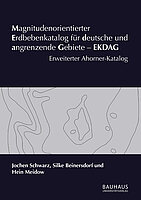motivation
Currently, various earthquake catalogues are available for the seismic areas ofGermany and adjacent countries. Due to obvious discrepancies concerning relevant parameters, the extent of published data and the covered time window, it was decided to create a new, revised earthquake catalogue. Different techniques for data comparison and data management were developed and applied for elaborating the final version.
The basic data are provided by a magnitude ML - based catalogue, unpublished to date, by L. Ahorner, which was developed and maintained over several decades of seismo-engineering and instrumental practice. Recently published reinterpretations of historical earthquakes are included. Fake events and inconsistencies between the catalogues are identified by comparing the original datasets. For a large number of relevant events with intensities I >= 5.0, referenced sources were investigated, leading to the interesting conclusion that over the generation of catalogues the responsible authors have contributed to significant confusion of reported facts and assigned parameters. This is particularly true for macroseismic intensity, epicentral coordinates and source depths. To make the final catalogue entries more transparent, the basic, decision-supporting information will be summarized and published within a series of papers.
Working in this field it becomes clear that more information on earthquakes is available than a catalogue of the common type could preserve. Therefore the catalogue is arranged as a database system and linked to a Geographic Information System (GIS). In ongoing works the prerequisites are provided to include damage cases (pictures, floor plans e.g.), macroseismic as well as shake maps and strong motion recordings. In the final stage of the intended work, catalogue entries are prepared as one module of an extended tool for risk assessment tasks, including the evaluation of regional predominant building types. The earthquake catalogue will be maintained by the Earthquake Damage Analysis Centre (EDAC) at Bauhaus-Universität Weimar.
-
PosterECEES_ID1956.pdf 821 KB
13. D-A-CH Tagung Erdbebeningenieurwesen und Baudynamik, Wien, Österreich
Beinersdorf, S.; Schwarz, J.; Meidow, H. (2013)
Ingenieuranwendungsorientierter Erdbebenkatalog für deutsche und angrenzende Gebiete (EKDAG). In proceedings: 13. D-A-CH Tagung Erdbebeningenieurwesen und Baudynamik, Wien, Österreich, 29-30 August 2013, Wien (accepted).
D–A–CH – Mitteilungsblatt – Erdbebeningenieurwesen und Baudynamik 2021/1
https://dgeb.org/getmedia.php/_media/dgeb/202104/273v0-orig.pdf
gedruckte Version
Jochen Schwarz, Silke Beinersdorf, Hein Meidow (2019):
Magnitudenorientierter Erdbebenkatalog für deutsche und angrenzende Gebiete – EKDAG
Erweiterter Ahorner-Katalog
Zentrum für die Ingenieuranalyse von Erdbebenschäden (ed.)
570 Seiten mit zahlreichen Abbildungen, Grafiken und Tabellen
ISBN: 978-3-95773-276-7
Preis: 250,00 € zzgl. Versandkosten


